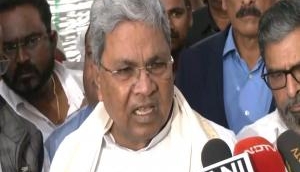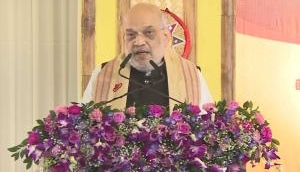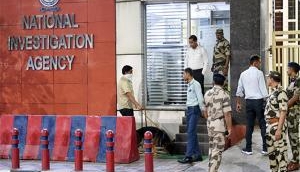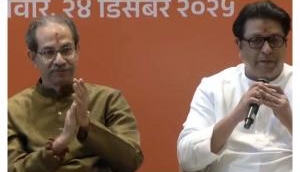
The US Commission on International Religious Freedom's report on religious tolerance in India has ruffled the government's feathers.
In a scathing criticism of the ruling government's alleged Hindutva policies, the report says that India is on a negative trajectory in terms of religious freedom. The USCIRF report reads:
Since the BJP assumed power, religious minority communities have been subject to derogatory comments by BJP politicians and numerous violent attacks and forced conversions by affiliated Hindu nationalist groups.
A cursory reading reveals that the report is just a repetition of its 2014-2015 edition - albeit with a few additions.
In fact, just like the last edition, this report also mentions BJP president Amit Shah's call for a nation-wide, anti-conversion law.
No line added, no line deleted.
The only way the 2015-2016 report is different from its predecessor is that the previous edition talked about having faith in Narendra Modi's leadership.
The new report, on the other hand, is far more grim in its outlook.
The report says:
"USCIRF will continue to monitor the situation closely during the year ahead to determine if India should be recommended to the U.S. State Department for designation as a "country of particular concern," or CPC".
By saying so, the USCIRF means that India could end up being put in the same category as countries like Iraq, Pakistan, Syria.

The instances of violence against minorities that the report hinges its observations on have all been widely reported in the Indian media - be it the Dadri lynching or instances of ghar wapsi or alleged forced conversions.
There is nothing that the report holds India accountable for, that the Indian media hasn't already reported about.
The report is preachy, while being embarrassingly low on facts. Take for example, the section on 'Violations against Sikhs'. Not only is this section vaguely-worded, but it is also misleading. The section reads:
Sikhs often are harassed and pressured to reject religious practices and beliefs that are distinct to Sikhism, such as wearing Sikh dress and unshorn hair, and carrying religious items, including the kirpan.
The Sikh community also reports that the Indian government ignores their religious freedom concerns by targeting Sikhs under the country's sedition law regardless of whether they in fact support the Khalistan movement (a political movement seeking full legal recognition of Sikhism and a Sikh state in the Punjab).
For example, in October 2015, Sikhs protested in Chandigarh, Punjab state after pages from the Sikh Holy Scripture (Guru Granth Sahib) were found desecrated. Police officers opened fire at the unarmed protesters, killing two and injuring 70 others, and several Sikh protesters were arrested under the sedition law.
There are multiple problems with this analysis. And two very obvious ones.
First, how did the report conclude that Sikhs in India are harassed or discriminated against, based on their religious attire or customs? Which were these instances? Is it fair to paint a country as being hostile to a certain community without any empirical data?
If anything, it is the US that has garnered a reputation for a torrent of racially-motivated attacks on the Sikh community in the wake of 9/11.
Second, the argument about Sikhs being charged with sedition is problematic.
The Punjab government slapped sedition charges on radical Sikh leaders - who had organised a Sarbat Khalsa - on 10 November, 2015 .
But what the report fails to acknowledge is that the Punjab government is headed by a Sikh-centric party, the Siromani Akali Dal. The police firing in which two Sikhs - protesting against desecration - were killed was also ordered by the SAD. The desecration row and the violence that followed is a much more complicated matter that the US report understands it to be.
The Ministry of External Affairs is perhaps right in saying the panel doesn't understand India's society and constitution.
"Government does not see the locus standi of a foreign entity like USCIRF to pronounce on the state of Indian citizens' constitutionally protected rights. We take no cognizance of their report," the MEA statement says.
What is the USCIRF?
The US Commission on International Religious Freedom was "created by the International Religious Freedom Act of 1998 (IRFA) as an entity separate and distinct from the State Department".
Its role is mainly advisory.
The body has two major functions:
1. To monitor religious freedom worldwide.
2. Making policy recommendations to the President, Secretary of State, and Congress.
In March 2016, the BJP government barred the USCIRF from visiting India. However, this was not the first time that the body has been denied permission to enter the country. In 2009 too, the UPA government had turned down visas to members of the body.
First published: 3 May 2016, 7:39 IST







![BJP's Kapil Mishra recreates Shankar Mahadevan’s ‘Breathless’ song to highlight Delhi pollution [WATCH] BJP's Kapil Mishra recreates Shankar Mahadevan’s ‘Breathless’ song to highlight Delhi pollution [WATCH]](https://images.catchnews.com/upload/2022/11/03/kapil-mishra_240884_300x172.png)

![Anupam Kher shares pictures of his toned body on 67th birthday [MUST SEE] Anupam Kher shares pictures of his toned body on 67th birthday [MUST SEE]](https://images.catchnews.com/upload/2022/03/07/Anupam_kher_231145_300x172.jpg)






